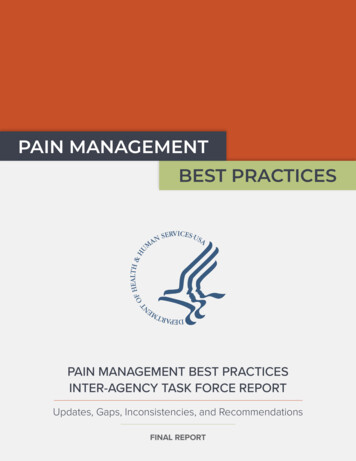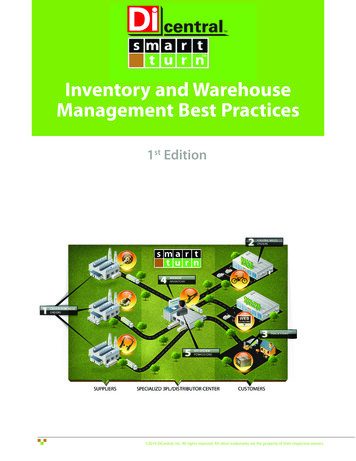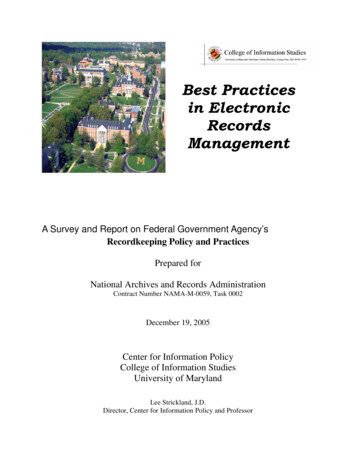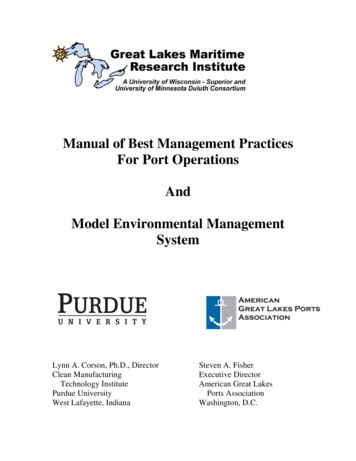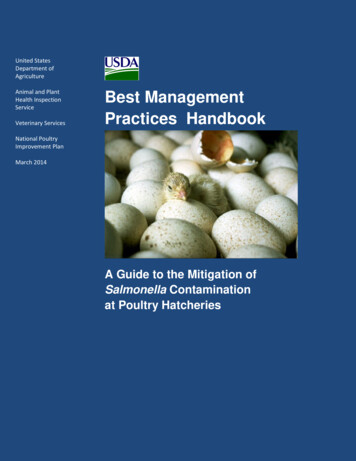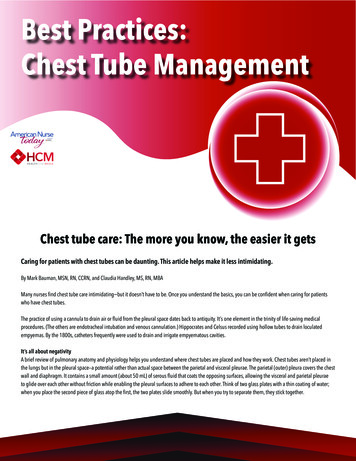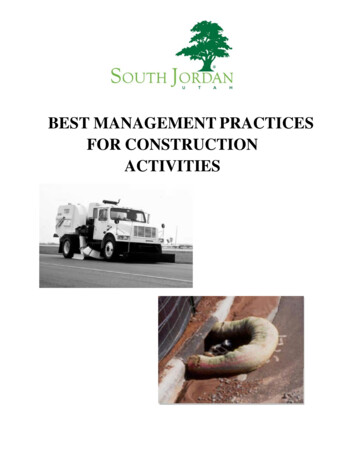
Transcription
BEST MANAGEMENT PRACTICESFOR CONSTRUCTIONACTIVITIES
BMP REFERENCE MANUALThis manual is intended as guidance for implementing stormwater Best ManagementPractices at construction sites. It does not represent all BMPs, but rather a presentation ofthe more common BMP’s accepted by South Jordan City.South Jordan City cannot be held liable for special, collateral, incidental or consequentialdamages in connection with or arising from using techniques presented in this manual.STORMWATER AND CONSTRUCTION ACTIVITIESA landowner or primary contractor who plans or conducts construction activity with a landdisturbance of greater than or equal to one acre, including projects less than one acre that are partof a larger common plan of development or sale is required to obtain a permit from the UtahDivision of Water Quality. The permit may be obtained on-line atwww.waterquality.utah.gov/updes/stormwater. Please note that the permit is requiredBEFORE construction starts. The permit requires the development and implementation of aStorm Water Pollution Prevention Plan (SWPPP) that identifies potential sources ofstormwater pollutants and Best Management Practices (BMPs) to reduce or eliminate theirimpacts.BMPs are practices that control stormwater sediment and erosion to the maximum extentpracticable (MEP). These controls include a wide range of structural and non-structural options.This booklet presents BMPs that are recommended by the Utah Division of Water Quality and theEnvironmental Protection Agency.Contractors may use this booklet as general guidance related to BMPs; it is up to thecontractor to select appropriate BMPs and implement and maintain these BMPs.Selection of BMPs will be site specific and deviation from those presented here may beappropriate given the conditions, contractor experience and new technology. Variations areacceptable provided implemented controls meet the intent of the BMP.
ADDITIONAL INFORMATIONSalt Lake County Stormwater Coalitionhttp://www.stormwatercoalition.org/Salt Lake County Department Flood Control tmlSalt Lake County Public Works Stormwater tate Division of Water mwater.htmUS Environmental Protection Agencyhttp://cfpub1.epa.gov/npdes/home.cfm?program id 6Center for Watershed Protectionhttp://www.cwp.org/Low Impact ttp://www.forester.net/sc.htmlWater Environment Federationhttp://www.wef.org/HomeStormwater Authorityhttp://www.stormwaterauthority.org/
TABLE OF CONTENTSFloGard Inlet protection.1Benching. 2Bioengineering. 3Building Repair, Remodeling, and Construction . 4Check Dams . 5Chemical Mulch . 6Compaction . 7Concrete Waste Management . 8Construction Road Stabilization . 9Construction Sequencing .10Contaminated or Erodible Surface Areas . 11Diversion Dike. 12Dust Controls . 13Earth Berm Barrier . 14Employee Training . 15Equipment & Vehicle Wash Down Area . 16Erosion Control Blanket . 17Filter Strips . 18Floatation Silt Curtain. 19Geotextiles and Mats . 20Hazardous Waste Management. 21Hydromulching. 22Inlet Protection – Excavated . 23Inlet Protection – Silt Fence/Straw Bale . 24Inlet Protection – Wattle . 25Inspection & Maintenance. 26Land Grading . 27Material Storage . 28Material Use . 29Mulching . 30Outlet Protection . 31Portable Toilets . 32Preservation of Existing Vegetation . 33Sandbag Barrier. 34Sediment Basin. 35Sediment Trap . 36Silt Fence. 37Slope Drain . 38Spill Clean-up . 39
TABLE OF CONTENTS(Continued)Stabilized Construction Entrance . 40Straw Bale Barrier. 41Street Sweeping . 42Surface Roughening . 43Temporary and Permanent Seeding and Planting . 44Temporary Drains and Swales . 45Temporary Stream Crossing . 46Vehicle and Equipment Cleaning . 47Vehicle and Equipment Fueling . 48Vegetated Buffers . 49Waste Disposal. 50
CINCHINGCORDSSPECIFIER CHARTCATCH BASIN IDMODEL NO.Inside Dimension(inch x inch)CURB 36D36X36YES- ----- !./OPTIONAL CURBINLET DAMCURBRIGID BYPASSLOUVERSRIGID BYPASS0UTLET H0LES--If---- NOTES:EXPANSIONRESTRAINT-1-"-t----BASIN BAG---t- ---1.FloGard T-Bag TM is manufactured fromwoven monofilament polypropylene fabric.Other materials available upon request.2.May be ordered with Fossil Rockpouches installed.3.Optional curb inlet dam available upon request.4.Periodic maintenance is required.FloGard T-Bag TM should never be allowed tofill beyond the top of the bypass outlet louvers.5.Appropriate lifting equipment should be usedwhen performing periodic maintenance.TMoil absorbentCATCH BASINSECTION VIEW-INSTALLEDWITH OPTIONAL CURB INLET DAMTITLEKriStar Enterprises, Inc. T-BAG 360 Sutton Place, Santa Rosa, CA 95407Ph: 800.579.8819, Fax: 707.524.8186, www.kristar.comTEMPORARY INLET PROTECTION DEVICEDRAWING NO.REVFG-TB-0001 AECO0059 JPR 12/30/0BDATEJPR 09/01/06SHEEr 1 OF 1
BEBMP: BenchingConstructionDESCRIPTION:Slope construction with benches spaced at regular intervals perpendicular to the slope whichintercept and collect sheet flow and direct it to a stable outfall point.APPLICATIONS: Unstabilized cut and fill slopes Large stockpiles Existing unstable slopesINSTALLATION/APPLICATION CRITERIA: Benches should be formed as slope is constructed and graded to the outlet point. Stabilized outlet with sediment controls should be in place prior to slope construction.LIMITATIONS: Construction slope design must accommodate benching Not appropriate for sandy or rocky soil Only effective if suitable outlet providedMAINTENANCE: Inspect after major storm events and at least biannually, repair any damaged areas. Remove debris blocking water flow. Inspect outlet, repair/replace sediment controls and remove sediment build up.2
BIOBMP: ng methods combine vegetative and mechanical techniques to stabilize eroding slopes.Bioengineering methods include sprigging, tubeling and wattling. Sprigging involves planting rhizomes,stolons, shoots or sprouts of a desirable species. Tubelings are forbs, shrubs, or trees commerciallyavailable in reusable plastic tubes or sleeves. Wattles are bundles of cuttings from live willows, alders, orsimilar plants placed and secured in trenches across a slope to aid in slope stabilization.APPLICATIONS: Sprigging may be performed on cut and fill slopes or other areas needing permanent soil stability. Tubelings may be placed on any area needing revegetation, but are most useful on slopes or flat areaswhere poor topsoil conditions inhibit successful seed germination and early plant growth. Wattles act to reduce slope length and aid in stabilizing slopes due to surface runoff, frost heaving,needle ice, or other soil movement.INSTALLATION/APPLICATION CRITERIA: Sprigging involves tearing sod apart; planting rhizomes or stolons, or transplanting shoots or sprouts.Sprigs are placed by broadcast, punching-in or with a special sprig planter. Tubelings involve drilling holes to the depth necessary to accommodate roots. Wattles are best applied to slopes no steeper than 2:1.LIMITATIONS: Availability of plant materials may affect what species can be used. May be necessary to arrange for commercially grown tubelings. Cannot be used as a substitute for retaining walls or similar devices to stabilize over steepened slopes.MAINTENANCE: Sprigging and tubeling plantings should be checked periodically until they are permanently established. Assess the need for replacement plantings or supplemental fertilizer.3
BMP: Building Repair, Remodeling, and ConstructionBRRCConstructionDESCRIPTION:Prevent or reduce the discharge of pollutants to stormwater from building repair, remodeling, andconstruction by using soil erosion controls, enclosing or covering building material storage areas,using good housekeeping practices, using safer alternative products, and training employees.APPLICATIONS: Use soil erosion control techniques if bare ground is temporarily exposed. Use permanent soil erosion control techniques if the remodeling clears buildings from an areathat are not to be replaced.INSTALLATION/APPLICATION CRITERIA: Enclose painting operations consistent with local air quality regulations and OSHA. Properly store materials that are normally used in repair and remodeling such as paints andsolvents. Properly store and dispose waste materials generated from the activity. Maintain good housekeeping practices while work is underway.LIMITATIONS: This BMP is for minor construction only. A licensed hazardous waste hauler must dispose of hazardous waste that cannot be re -usedor recycled. Safer alternative products may not be available, suitable, or effective in every case. Be certain that actions to help storm water quality are consistent with OSHA and air qualityregulations.MAINTENANCE:None4
CDBMP: Check DamsConstructionDESCRIPTION:A small, temporary dam constructed across a drainage ditch to reduce velocity of concentratedstorm water flows, thereby reducing the erosion of the ditch.APPLICATIONS: Temporary drainage paths Permanent drainage ways not yet stabilized Existing drainage paths receiving increased flows due to constructionINSTALLATION/APPLICATION CRITERIA: Prepare location of dam by removing any debris and rough grading any irregularities inchannel bottom Place rocks by hand or with appropriate machinery; do not dump Space dams to make the base of the upstream dam the same elevation as the top of the nextlower dam Construct dam to pass design flows with center lower to create a weir effect Construct 50% side slopes on damLIMITATIONS: Maximum recommended drainage area is 10 acres Maximum recommended height is 24" Do not use in running streamMAINTENANCE: Inspect dams at a minimum of twice monthly, after each major rain event, and daily duringprolonged rainfall. Remove any large debris and repair any damage to dam, channel or sideslopes. Remove accumulated sediment when it re
similar plants placed and secured in trenches ac ross a slope to aid in slope stabilization. APPLICATIONS: Sprigging may be performed on cut and fill slopes or other areas needing permanent soil stability. Tubelings may be placed on any area needing




